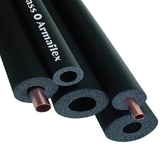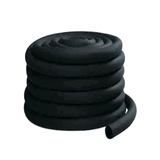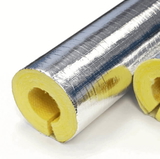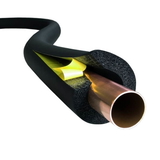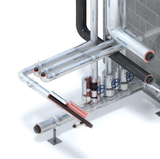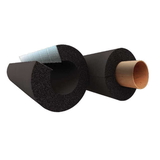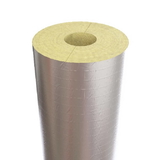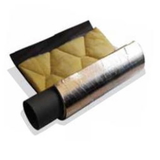- Blogs
- Efficient Pipe Insulation: A Guide to Weatherising Your Plumbing
Efficient Pipe Insulation: A Guide to Weatherising Your Plumbing

If you want to protect your plumbing system from freezing, bursting, and wasting energy, you need to insulate your pipes. Pipe insulation is a simple and cost-effective way to keep your hot water pipes warm and your cold-water pipes cool.
It also helps reduce plumbing noise, mould growth, and heat loss. In this article, I will show you how to insulate your pipes using different types of materials and methods. I will also give you some tips on how to maintain your pipe insulation and prevent condensation issues.
Why Do You Need Pipe Insulation?
Pipe insulation is essential for any home, especially in the UK, where the winters can be harsh and unpredictable. Without proper insulation, your pipes can be exposed to cold air and water, which can cause them to freeze and expand. This can lead to cracks and leaks, which can damage your walls, floors, and ceilings, and cost you a lot of money in repairs. Pipes that are located in unheated areas, such as basements, attics, garages, and exterior walls, are particularly vulnerable to freezing.
Pipe insulation can also help you save energy and money by reducing heat loss from your hot water pipes.
According to the Energy Saving Trust, Adding a thicker insulation layer to your hot water tank, going from 25mm to 80mm with a standard British jacket, might save you about £50 per year. This is more than what the jacket itself costs. This can also improve the efficiency and performance of your boiler and heating system, and reduce your carbon footprint. Pipe insulation can also prevent mould growth and corrosion, which can affect the quality and safety of your water supply.
Another benefit of pipe insulation is that it can reduce plumbing noise, which can be annoying and disruptive. Plumbing noise can be caused by a water hammer, which is the banging sound that occurs when water suddenly stops or changes direction in the pipes. Pipe insulation can absorb some of the vibrations and sounds, and create a quieter and more comfortable environment.
How to Choose the Right Pipe Insulation
 There are many types of pipe insulation available in the market, and each one has its own advantages and disadvantages. The main factors you need to consider when choosing pipe insulation are:
There are many types of pipe insulation available in the market, and each one has its own advantages and disadvantages. The main factors you need to consider when choosing pipe insulation are:
-
The size and shape of your pipes
-
The temperature and location of your pipes
-
The material and thickness of the insulation
-
The cost and availability of the insulation
The most common types of pipe insulation are:
-
Fibreglass pipe Insulation: This is a flexible and lightweight material that can be used for pipes with many bends and turns. It can also withstand high temperatures, making it suitable for pipes near furnaces and water heaters. However, fibreglass can be irritating to the skin and lungs, so you need to wear protective gear when working with it. You also need to secure it with tape or glue, which can be messy and time-consuming.
-
Tubular pipe insulation: This is a pre-formed and pre-cut material that can be easily slipped over straight pipes. It comes in different sizes and materials, such as polyethene foam, rubber foam, and mineral wool. Some tubular insulation has a self-seal feature, which makes it easier to install and remove. However, tubular insulation may not fit well on pipes with valves, joints, and fittings, and it may not be suitable for high-temperature pipes.
How to Install Pipe Insulation
Before you start installing pipe insulation, you need to prepare your pipes and gather the necessary tools and materials. Here are the steps you need to follow:
-
Clean your pipes: Use a rag and a mild cleanser to remove any dirt, grease, or rust from your pipes. Make sure your pipes are completely dry before applying the insulation.
-
Measure your pipes: Use a tape measure to determine the length and diameter of your pipes. You may also need to measure the circumference and angle of any bends, valves, joints, and fittings. Write down the measurements and use them to buy the right size and amount of insulation.
-
Cut your insulation: Use a sharp knife or scissors to cut your insulation according to your measurements. If you are using fibreglass pipe wrap, unroll it and cut it with the foil side facing up. If you are using tubular pipe insulation, cut it along the slit or the seam.
-
Apply your insulation: Depending on the type of insulation you are using, you may need to wrap or slip it over your pipes. Make sure the insulation covers the entire surface of the pipes, and that there are no gaps or overlaps. If you are using fibreglass pipe wrap, slightly overlap the wrap as you go, and secure the ends with tape or glue. If you are using tubular pipe insulation, slip it over the pipes and seal the slit or the seam with tape or glue.
-
Finish your insulation: After applying the insulation, you may need to add some finishing touches, such as:
-
Covering the insulation with a protective layer, such as foil, plastic, or cloth, to prevent damage and moisture.
-
Using T-foam connectors and elbow foam connectors to insulate corners and complex angles.
-
Using pipe insulation tape or pipe insulation clips to secure the insulation and prevent it from slipping or sagging.
-
Labeling the pipes and the insulation with the type, size, and date of installation, to make it easier to identify and maintain them.
-
How to Maintain Pipe Insulation
 After installing pipe insulation, you need to check and maintain it regularly to ensure its effectiveness and durability. Here are some tips on how to maintain your pipe insulation:
After installing pipe insulation, you need to check and maintain it regularly to ensure its effectiveness and durability. Here are some tips on how to maintain your pipe insulation:
-
Inspect your insulation: At least once a year, inspect your insulation for any signs of damage, wear, or deterioration, such as:
-
Tears, holes, or cracks in the insulation or the protective layer
-
Loose, sagging, or missing insulation
-
Wet, damp, or mouldy insulation
-
Discoloured, stained, or corroded insulation
-
Rodent or insect infestation
-
-
Repair or replace your insulation: If you find any problems with your insulation, you need to repair or replace it as soon as possible, to prevent further damage and heat loss. You can use the same type and size of insulation, or you can upgrade to a better one, depending on your needs and budget. You can also use pipe insulation repair tape or pipe insulation repair kits to fix minor issues, such as small holes or tears.
-
Prevent condensation: Condensation is the formation of water droplets on the surface of your pipes or insulation, due to the difference in temperature and humidity between the inside and outside of the pipes. Condensation can cause several problems, such as:
-
Damaging your pipes and insulation, and causing corrosion and rust
-
Promoting mould and mildew growth, and affecting the air quality and health of your home
-
Wasting water and energy, and increasing your bills
-
To prevent condensation, you need to:
-
Choose the right type and thickness of insulation, and make sure it fits snugly and securely on your pipes.
-
Insulate your cold-water pipes as well as your hot-water pipes, especially in humid areas, such as bathrooms and kitchens.
Conclusion
Pipe insulation is a smart and easy way to protect your plumbing system and save energy and money. By following the steps and tips in this article, you can insulate your pipes using different types of materials and methods, and prevent freezing, bursting, and condensation issues.
You can also visit our website Buy Insulation Online to find the best deals and offers on pipe insulation and other insulation products. We are the UK’s top Pipe Insulation supplier, and we have a wide range of brands and sizes to suit your needs. Contact us today and let us help you with your insulation project.

Samuel Hitch
Managing Director
Buy Insulation Online.
Leave A Reply
Your feedback is greatly appreciated, please comment on our content below. Your email address will not be published. Required fields are marked *










